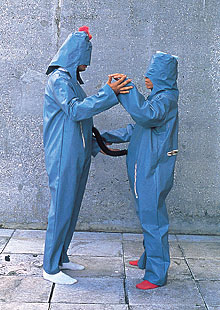
Lygia Clark, The I and the You: Clothing-Body-Clothing Series, 1967. Interactive objects. Museu de Arte Moderna do Rio de Janeiro, Clark Family Collection. Photo courtesy of Museu de Arte Moderna do Rio de Janeiro, Familia Clark Collection.

The 1950s, which saw the construction of Brazil’s new utopian capital, Brasilia, and the formation of the São Paulo Bienal, was a period of democracy and relative economic prosperity in the country. It was within a climate of increased internationalism that the distinctive form of geometrically based painting and sculpture called Concrete Art was established. Swiss artist Max Bill, who had exhibited his work at the Museu de Arte de São Paulo in 1950 and returned the following year to win a major prize at the first São Paulo Bienal, had inspired many younger artists in Brazil, such as Luis Sacilotto, to work in a style related to his.
Among the aims of Concrete Art was the distancing of visual expression from figurative art, which had played such a strong role in the past. Concrete artists would be attuned to contemporary theories of cybernetics, Gestalt psychology, and the optical experiments of international artists such as Victor Vasarely and Bridget Riley.
While Concrete Art first found expression in São Paulo, Rio de Janeiro was the site of some important innovations in the late 1950s. The artists who had belonged to the first wave of Concretism were dismayed to see a lessening in the rigor of color and form in the works displayed. Artists from Rio de Janeiro such as Lygia Clark, Hélio Oiticica, and Lygia Pape, became more and more interested in experimenting with a wide range of color and inserting a greater sensuality or poetic feeling into their art.
Ultimately, some of the members of the Neo-Concrete group, especially Clark and Oiticica, went on to develop methods of creating art that embraced notions of performative interactivity between the art object and the spectator.
—Edward J. Sullivan